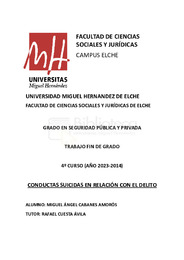Por favor, use este identificador para citar o enlazar este ítem:
https://hdl.handle.net/11000/33521Registro completo de metadatos
| Campo DC | Valor | Lengua/Idioma |
|---|---|---|
| dc.contributor.advisor | Cuesta Ávila, Rafael | - |
| dc.contributor.author | Cabanes Amorós, Miguel Ángel | - |
| dc.contributor.other | Departamentos de la UMH::Ciencia Jurídica | es_ES |
| dc.date.accessioned | 2024-10-16T11:53:41Z | - |
| dc.date.available | 2024-10-16T11:53:41Z | - |
| dc.date.created | 2024-06 | - |
| dc.identifier.uri | https://hdl.handle.net/11000/33521 | - |
| dc.description.abstract | Empezaremos informando que el suicidio está al frente en nuestro país de muertes no naturales, es decir, muertes violentas. De un tiempo a esta parte, la cantidad de suicidios han aumentado en la sociedad en general y según los datos de la Organización Mundial de la Salud, gran cantidad de estas muertes se podrían haber evitado a través de efectivos protocolos de prevención. En lo relativo a la colectividad delictiva y a las distintas Fuerzas y Cuerpos de Seguridad, en los últimos años, se han incrementado notablemente las tasas de suicidios, razón que estimula a estudiar los motivos que llevan a este fatal desenlace. Aunque sean dos grupos totalmente diferentes y opuestos, ambos se pueden discernir desde un mismo enfoque sociológico. Lo realizaremos desde la perspectiva teórica clásica de Émile Durkheim. | es_ES |
| dc.description.abstract | We are going to start informing that suicide is the leader of unnatural deaths in our country, that is, violents deaths. Some time ago, the quantity of suicides has raised in the society in general and according to World Health Organization, the most mayority of these deaths, could be avoided through prevention effective protocols. In reference to the criminal group and different Security Forces, in the last years, the number of suicides has raised significantly, this is the reason that encourages to study the causes of this fatal end. Although, they are two different and opposite groups, both can be distinguished since the same sociological approach. We are going to do since the classic theoretical perspective of Émile Durkheim. | es_ES |
| dc.format | application/pdf | es_ES |
| dc.format.extent | 53 | es_ES |
| dc.language.iso | spa | es_ES |
| dc.publisher | Universidad Miguel Hernández de Elche | es_ES |
| dc.rights | info:eu-repo/semantics/openAccess | es_ES |
| dc.rights | Attribution-NonCommercial-NoDerivatives 4.0 Internacional | * |
| dc.rights.uri | http://creativecommons.org/licenses/by-nc-nd/4.0/ | * |
| dc.subject | Suicidio | es_ES |
| dc.subject | delincuente | es_ES |
| dc.subject | Fuerzas Cuerpos de Seguridad | es_ES |
| dc.subject | enfoque sociológico | es_ES |
| dc.subject | Durkheim | es_ES |
| dc.subject | Suicide | es_ES |
| dc.subject | criminal group | es_ES |
| dc.subject | Security Forces | es_ES |
| dc.subject | sociological approach | es_ES |
| dc.subject.other | CDU::3 - Ciencias sociales | es_ES |
| dc.title | Conductas suicidas en relación con el delito | es_ES |
| dc.type | info:eu-repo/semantics/bachelorThesis | es_ES |

Ver/Abrir:
TFG-Cabanes Amorós, Miguel Ängel.pdf
974,04 kB
Adobe PDF
Compartir:
 La licencia se describe como: Atribución-NonComercial-NoDerivada 4.0 Internacional.
La licencia se describe como: Atribución-NonComercial-NoDerivada 4.0 Internacional.
.png)